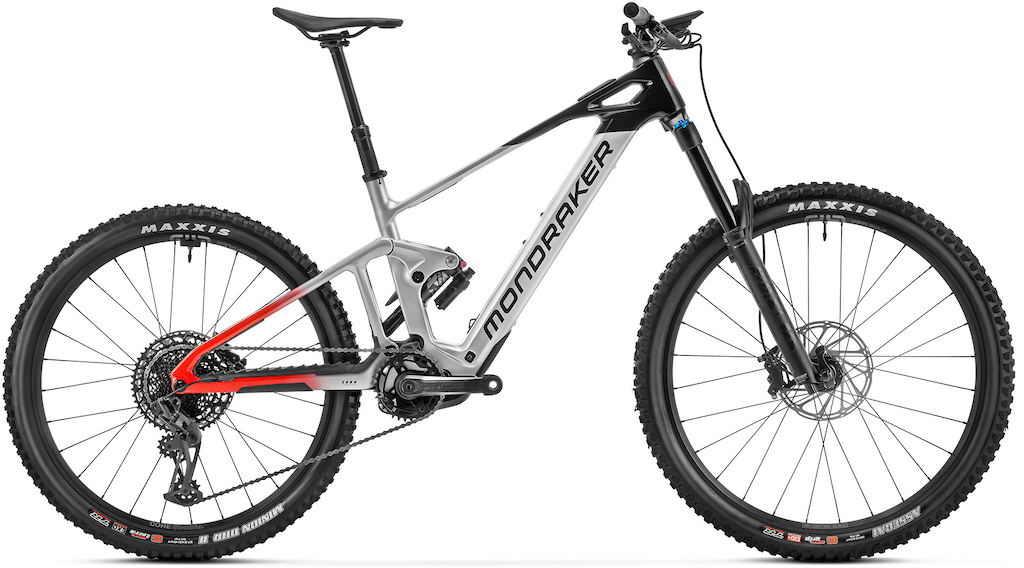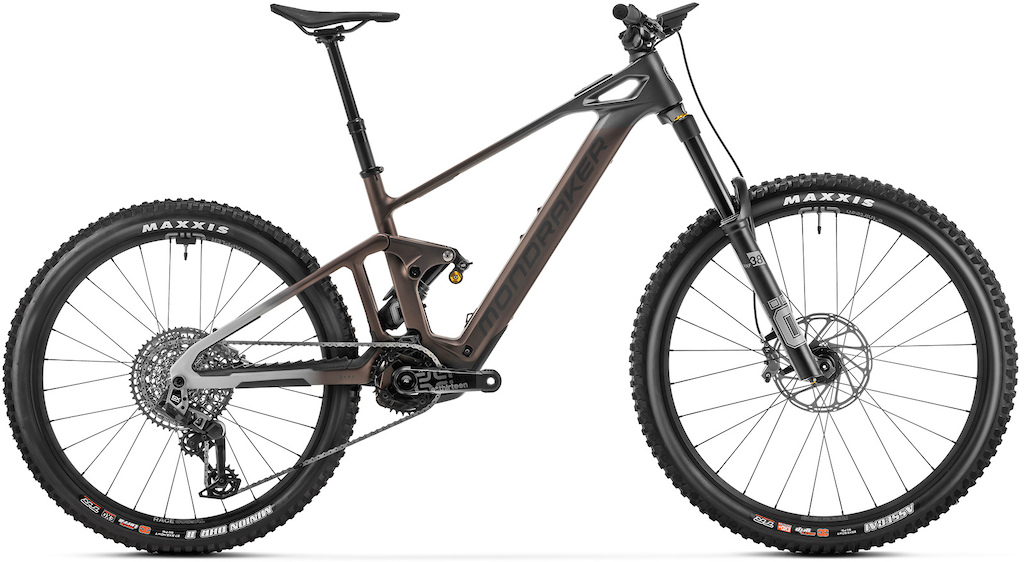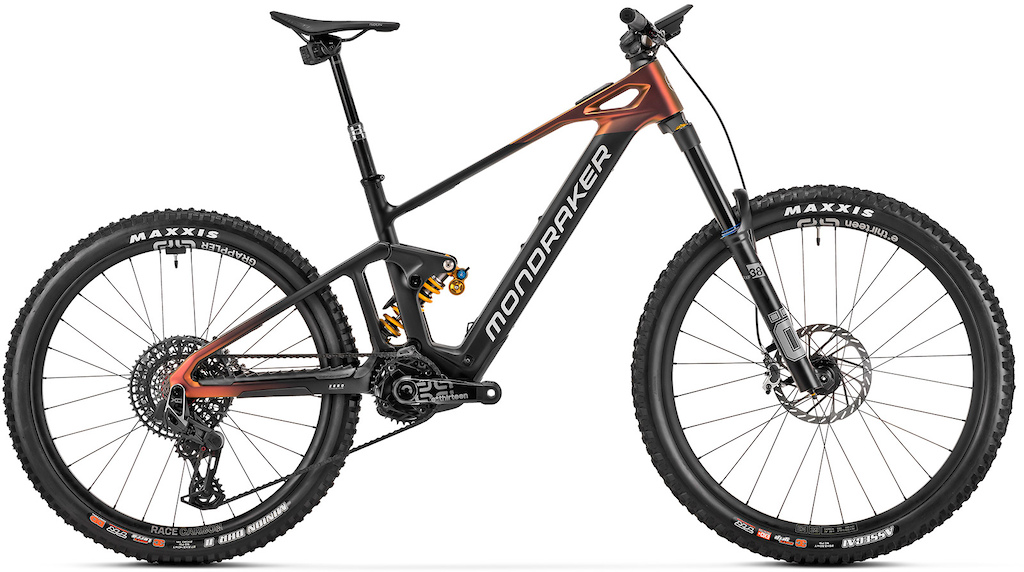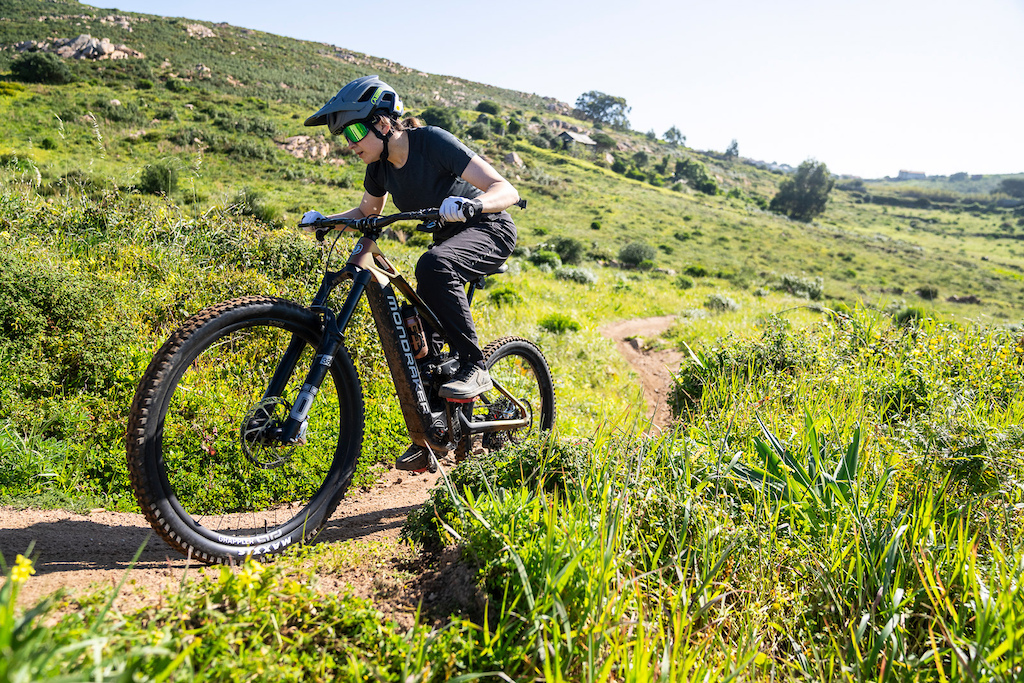First Ride: 2024 Mondraker Dune eMTB - Punchy, Maneuverable, & Light Enough
The Mondraker Dune is the latest mountain bike subject to reappropriation with an electric motor, positioned as the Super Enduro of light(er) e-bikes. This is more overhaul territory, rather than some basic updates, and arguably worthy of a name change. However, the Dune's intentions, at least from a descending standpoint, remain unchanged. While the 2017 iteration was a 27.5" wheeled affair, 2024 sees it switch to a dedicated MX configuration across the S-XL size range, with 165mm of rear wheel travel delivered by the Updated Zero Suspension platform. That's paired with a 170mm or 180mm fork, depending on the model. Most notably, the Dune is home to a 55 Nm Bosch SX motor and a 400 Wh battery, and weighs just shy of 20 kg (43 lbs).
2024 Mondraker Dune Details
• Full Carbon Frame
• 165mm Rear Wheel Travel
• 170/180mm Fork (XR)
• 64°/63.5° head angle
• MX Wheels
• Bosch SX Motor, 55 Nm & 600 W peak power
• 400 Wh battery (250 Wh Range Extender available)
• Weight: 19.92 kg / 42.5 lbs (actual, S)
• Sizes: S, M, L, XL; 440-500 mm reach
• Price: $11,999 USD (Dune XR)
• Lifetime warranty
• mondraker.com
• Full Carbon Frame
• 165mm Rear Wheel Travel
• 170/180mm Fork (XR)
• 64°/63.5° head angle
• MX Wheels
• Bosch SX Motor, 55 Nm & 600 W peak power
• 400 Wh battery (250 Wh Range Extender available)
• Weight: 19.92 kg / 42.5 lbs (actual, S)
• Sizes: S, M, L, XL; 440-500 mm reach
• Price: $11,999 USD (Dune XR)
• Lifetime warranty
• mondraker.com
Mondraker now offers no fewer than seven full suspension eMTBs, most of which belong to the all-mountain category with 150mm travel and a complete 29" wheelset. Thus, the new Dune is far from the Spanish brand's first rodeo. The most recent addition to the lineup was the Mondraker NEAT, their first foray into the world of light(er) weight eMTBs, or SLs, as they have come to be known. The Dune sits alongside the NEAT as a longer-travel, more powerful SL option.
I got to ride the Dune on the enduro trails around Sintra, Portugal, and have some first ride impressions to share.
Frame Details & Motor
The Mondraker Dune has a carbon frame, inclusive of the rocker link, while the lower link is aluminum. Mondraker has managed to package the Dune with the Bosch SX motor and its 400 Wh battery, while leaving space for both the PowerMore 250 Wh range extender and a water bottle (M-XL, only). Or, if bigger mileage isn't on the agenda, two water bottles.
As is the case on most SL eBikes, the 400 Wh battery is not easily removed for charging off the bike. To get it out, the motor must be dropped out first, making it impractical to do anything but charge it in situ. The sensor for the Bosch SX motor is contained on the valve stem, and a wireless remote on the handlebar is used to switch modes.
Like the TQ-powered NEAT and the F-Podium XC bike, the Dune has moved to the Updated Zero Suspension design.
We'll go into the kinematics shortly, but it's first worth mentioning other implications of the layout. As the shock sits within a tunnel created by the two struts of the seat tube, insertion depth is somewhat limited, and so too are the options for longer travel dropper seat posts that most of us are, happily, now accustomed to. Stock dropper lengths on the top-end XR model are as follows: S (125mm), M (150mm), L & XL (170mm). The more affordable RR, and R models get the adjustable Onoff Pija dropper, with the following drop lengths: S (125mm), M (120-150mm), L (140-170mm), XL (170-200mm) - so, a slight improvement for the tallest riders.
Protection has been considered, with comprehensive chain slap coverage along the chainstay, and a thinner strip added to the underside of the seat stay, too. There's a micro fender bolted to the back of the seat tube, just above the shock tunnel, to protect the shock from some debris deposited by the rear tire.
Geometry
The Dune continues with Mondraker's Forward Geometry concept, their marketing term for the "longer, lower, and slacker" trend, of which they were very early adopters. There are four sizes ; S, M, L & XL, with reach numbers evenly distributed at 440mm, 460mm, 480mm and 500mm, respectively. Seat tube lengths are relatively short at 380mm, 420mm, 450mm, and 490mm, respectively. However, as already mentioned, the insertion depth is the limiter in terms of dropper seat post length.
The flagship XR model is the only one to run a 180mm travel fork and a coil shock. The R and RR models run an air shock and a 170mm fork. As such, the XR is the slackest with a 63.5° head angle and a 77.1° effective seat tube angle, while the R and RR models get a 64° HA and a 77.5° SA. The abovementioned reach figures also grow by 5mm each for the R and RR.
Chainstay length is consistent across all sizes at 445mm. For the XR, the BB sits 3mm higher than the rear axle at a height of 353mm. It's a zero drop for the R & RR, at a height of 350mm. The small and medium bikes are equipped with 165mm cranks, while the large and extra large bikes get 170s.

The XR model is coil-equipped, while the more affordable RR and R models run air; Ohlins on the RR, and Fox on the R
Suspension
The Dune makes use of the Updated Zero Suspension Platform to deliver 165mm of rear wheel travel through a 205x65mm trunnion mounted shock. It's still a twin-link platform wherein two short links co-rotate as the rear wheel is displaced. However, instead of the shock being driven by that lower link, it's now driven by the swingarm itself.
Happily, there is nothing out of the ordinary about the Dune's kinematic. The average leverage ratio comes in at 2.53, starting just shy of 3.1, and finishing up just north of 2.3. While the vast majority of the curve is progressive, there is a small portion near bottom-out where the curve is slightly regressive.
Mondraker have given the Dune higher anti-squat values than they would for a comparable non-motorized enduro bike. Around sag, anti-squat sits at 128% for the easiest gear. That's intentional, and arguably desirable given that there's a great deal more acceleration to be had out of an eMTB. Anti-rise is relatively high; it's around 95% at sag, and doesn't dip below 88% at any point throughout the travel.
Models
It's quite uncommon for an e-bike manufacturer to make a frameset available, but Mondraker is doing just that with the Dune eMTB. Meanwhile, they will also sell it as a complete bike with three models to choose from. The frameset will retail at $6,799 USD, and will be available in "limited quantities". While some will surely be enamored by the opportunity to build up a Dune with their own carefully selected components, the value proposition doesn't seem quite so appealing when you see that for only $1,200 USD more, you can get a complete bike in the form of the Dune R.
The Dune R runs a custom tuned Fox Float X Performance shock and a 170mm Fox 38 Performance fork with the Grip damper. It gets SRAM DB8 brakes and the GX mechanical 12-speed drivetrain, and e*Thirteen Grappler e*spec wheels with 30mm aluminum rims.
The Dune RR also runs an air shock and a 170mm fork, giving it a slightly steeper set of geometry figures than those of the XR. This one offers Ohlins suspension components; the TTX Air shock and the RXF 38 fork with an updated damper. It rolls on e*Thirteen Grappler Race wheels. The drivetrain is upgraded to the electronic SRAM GX AXS Transmission, and the brakes are SRAM Code with the Bronze Stealth levers and 200mm rotors.
Emptying your savings account is the Dune XR, reviewed here. This one gets e*Thirteen's Grappler Carbon wheelset, and TRS Race Carbon cranks, SRAM Code Ultimate Stealth brakes, and the XO Eagle AXS Transmission group. The Ohlins RXF 38 fork fronts it, with the Ohlins
Ride Impressions
The Bosch SX motor is impressive. Despite having a modest 55 Nm torque and a sub 2kg weight, it actually has the capacity to deliver the same 600 W peak power of the meatier 85 Nm CX motor. However, you have to pedal faster to convince it to give you that. While the 2.9 kg CX motor will give you 600 W at a cadence of just 70 kg, the Bosch SX asks you to spin at 100 rpm before it will dish out the big watts. That lends itself to an intuitive ride experience for those coming onto the Dune from a regular motorless mountain bike. Learning the motor's behavior was relatively easy. As you would on a regular bike, you need to rapidly increase your cadence to get the power needed to drive up and over steep rocky features.
It's much louder on the trail than the TQ HPR-50 motor, a somewhat comparable 50 Nm motor, but is much more powerful and punchy for stomping up steep, technical sections. It also has the added benefit of the Extended Boost feature, wherein the motor continues to deliver power to the rear wheel up to 2 meters after its rider has stopped pedaling. There are four riding modes; Eco, Tour, eMTB and Turbo, all of which are tunable in terms of the level of assistance they provide, and their "dynamism", or how quickly they respond to pedaling inputs. Only the eMTB and Turbo modes deliver the Extended Boost.
There's also a Walk mode that can be activated by holding the down button on the remote for several seconds, which is super helpful following a forced dismount on a steep climb. I found it to be of variable efficacy, dependent on what gear I was in and how loose the terrain was. At the very least, it is useful in helping you prevent the bike from rolling back down the hill.
With the 400 Wh battery on a full charge, I managed around 32.5 km and 1625 meters of elevation gain. I spent most of that time switching between eMTB mode and Turbo, only going down to Tour toward the very end of the ride when I was getting very close to emptying the tank.
On the descents, the Dune is far from indistinguishable from an unassisted enduro bike, but it's easily the most natural handling example I've ridden thus far. To contextualize that, it is also the very first SL I've had the opportunity to ride, so I'm not at all surprised to find that this sub-20 kg ebike handles better than the heavier full-powered counterparts.
I rode the XR model in a size small, with a 440mm reach and a 35mm stem. The bar was also cut down to my preferred 740mm, with the stack slammed. The 343 lbs spring that comes stock on the small gave me 26% sag (Mondraker's recommendation is anywhere between 25% and 30%). A softer spring was not available. I ran the HSC, LSC, and rebound fully open.
The bike is pretty easy to get on with. The 63.5° head angle is as confidence-inspiring on steep ground as you might expect, and the 77.1° seat tube angle is sufficiently steep for comfort on prolonged fire road climbs. Certainly, I did not feel the need to push my saddle forward on the rails to make it any steeper.
The bike tips into corners quite naturally, not requiring too much more aggression to set up than a regular enduro bike. To call it nimble would be overly generous, but it isn't as sluggish as some of its numbers might suggest and it is sufficiently maneuverable to give its rider that sense of self-determination that I feel is the essence of a good time.
On the second day of riding in Sintra, I did switch to the Ohlins TTX air shock of the RR model. That gave me the opportunity to run a more standard 30% sag. On the whole, I'd say the coil setup gave a plusher, more controlled feeling to the bike, while the air shock gave it a little more pop, making it easier to get a good boost off lips and drops. It was harsher deeper into its travel however, and required a few clicks of LSC and rebound damping to get it feeling safer and more predictable. The stock air shock comes with two volume spacers (equivalent to 12,000mm³ of a possible 20,000mm³). I found myself bottoming out frequently on one of the faster DH-like tracks of Sintra, and so an additional volume spacer would have been ideal.
On both the air and coil shocks, the rear wheel had a tendency to feel a little light and unsettled under hard braking on steeper terrain. It was nothing too dramatic, and could well have been attributable to the soft, damp soil conditions, but I did feel this sensation fairly consistently over the two days of riding.
The rattle from the Bosch SX motor is easily audible. For me, that's not really a deal breaker, though some will of course find it a nuisance. Once I had determined the motor to be the source of the rattle, I was able to put it out of my mind. The only other noise was the whir of the three double-stepped pawls inside the e*Thirteen e*spec hub.
What is a deal breaker is the 125mm dropper seat post. While other aspects of the fit were very good, this lack of clearance is woeful. While it may be appropriate for an XC bike, or a short travel trail bike, it has no place on a 165mm travel enduro eMTB. Sadly, the clearance issue had the saddle slapping me on the backs of my thighs on even the mellower descents. I did drop the post to its deepest point to get around 15mm extra clearance, taking the hit of the then lower seated pedaling position.
I measured the maximum insertion depth at 186mm. The only saving grace here is that, in the context of my saddle height (632mm), it is possible to run a 150mm dropper from OneUp components.
Mondraker tell us the maximum insertion depth for the other frame sizes is as follows:
• Size M: 216 mm
• Size L: 248 mm
• Size XL: 282 mm
Author Info:
Must Read This Week


















Add to that the CSU creak that developed on my Mezzer and I’m not sure they’re up for heavier riders/ebikes.
Just been through a whole "my bike is too short" drama due to feeling cramped and too forward, I was using a 180mm dropper at 5ft10, took the dropper out, put in a bmx seat slammed, bike felt the right size again, so much better placed on on the bike, ie lower with space to move. Moved onto a bike I can run a 240mm dropper.
Remember that question, rigid bike with dropper or suspension with full height seat, I'll 100% "compromise" on suspension layout for more seatpost insertion.
The seat tube length is a killer. 420mm for a medium seat tube is long 400mm about right. But a max insertion of 216mm is really bad. The insertion lengths of the Oneup are as follow: 150mm (237mm), 180mm (267mm), 210mm (297mm). As you can see you can't even slam a 150mm dropper and that's unacceptable. A medium frame should be designed to slam a 210mm. Shorter leg riders benefit from more clearance.
magura.com/en/EUR/technology_innovation/bicycle/magura_cockpit_integration
The challenge is making the lever placement adjustable
Hope I get answers.
"Benefits" for us are a supposed cleaner look. Personally I couldn't care less about that.
Wtf? 2012 called, they want their 125mm droppers back.
For once, there is an even bigger deal breaker than the headset routing.
Massive fail
And WHY is the insertion depth so shit? Makes this bike unbuyable
Becuase they were so early on it, they have more right than most brands to boast about their geometry IMO, even if their head angles tend to be too steep for my taste now.